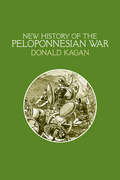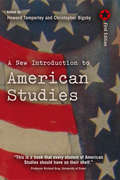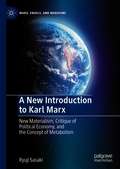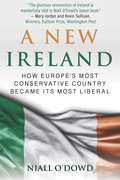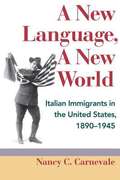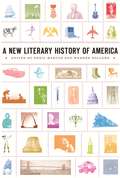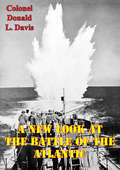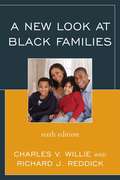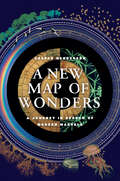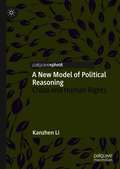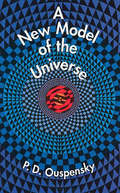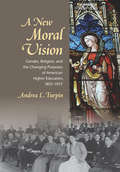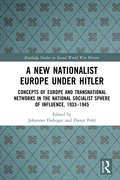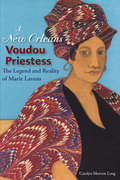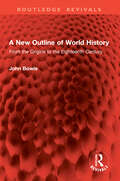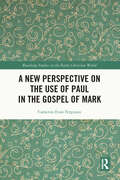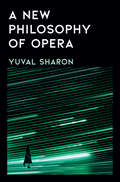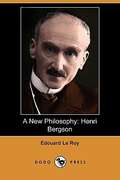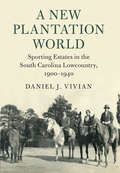- Table View
- List View
A New History of the American West
by Richard WhiteA centerpiece of the New History of the American West, this book embodies the theme that, as succeeding groups have occupied the American West and shaped the land, they have done so without regard for present inhabitants. Like the cowboy herding the dogies, they have cared little about the cost their activities imposed on others; what has mattered is the immediate benefit they have derived from their transformation of the land.
A New History of the Church in Wales: Governance and Ministry, Theology and Society
by Norman DoeThis book marks the centenary of the Church in Wales, following its disestablishment in 1920. Part I provides a historical overview: from the Age of the Saints to Victorian times; the disestablishment campaign; Christianity in Wales since 1920; and broad issues faced over the century. Part II explores the constitution, bishops and archbishops, clergy, and laity. Part III examines doctrine, liturgy, rites of passage, and relations with other faith communities. Part IV deals with the church and culture, education, the Welsh language, and social responsibility. Part V discusses the changing images of the Church and its future. Around themes of continuity and change, the book questions assumptions about the Church, including its distinctive theology and Welshness, ecumenical commitment, approach to innovation, and response to challenges posed by the State and wider world in an increasingly pluralist and secularised Welsh society over the century.
A New History of the Future in 100 Objects: A Fiction
by Adrian HonA riveting imagined history looking back on the twenty-first century through one hundred of its artifacts, from silent messaging systems to artificial worlds on asteroids.In the year 2082, a curator looks back at the twenty-first century, offering a history of the era through a series of objects and artifacts. He reminisces about the power of connectivity, which was reinforced by such technologies as silent messaging--wearable computers that relay subvocal communication; quotes from a self-help guide to making friends with "posthumans"; describes the establishment of artificial worlds on asteroids; and recounts pro-democracy movements in epistocratic states. In A New History of the Future in 100 Objects, Adrian Hon constructs a possible future by imagining the things it might leave in its wake.
A New History of the Peloponnesian War
by Donald KaganA New History of the Peloponnesian War is an ebook-only omnibus edition that includes all four volumes of Donald Kagan's acclaimed account of the war between Athens and Sparta (431–404 B.C.): The Outbreak of the Peloponnesian War, The Archidamian War, The Peace of Nicias and the Sicilian Expedition, and The Fall of the Athenian Empire. Reviewing the four-volume set in The New Yorker, George Steiner wrote, "The temptation to acclaim Kagan's four volumes as the foremost work of history produced in North America in the twentieth century is vivid. . . . Here is an achievement that not only honors the criteria of dispassion and of unstinting scruple which mark the best of modern historicism but honors its readers."All four volumes are also sold separately as both print books and ebooks.
A New Introduction to American Studies
by Christopher Bigsby Howard TemperleyA New Introduction to American Studies provides a coherent portrait of American history, literature, politics, culture and society, and also deals with some of the central themes and preoccupations of American life. It will provoke students into thinking about what it actually means to study a culture. Ideals such as the commitment to liberty, equality and material progress are fully examined and new light is shed on the sometimes contradictory ways in which these ideals have informed the nation's history and culture. For introductory undergraduate courses in American Studies, American History and American Literature.
A New Introduction to Karl Marx: New Materialism, Critique of Political Economy, and the Concept of Metabolism (Marx, Engels, and Marxisms)
by Ryuji SasakiThis book provides a concise overview of Marx’s philosophy and political economy, tracing various changes of his theoretical views over time through his practical and theoretical engagements with contradictions of capitalism from the unique perspective of Japanese Marxism. While it offers an objective introduction to Marx’s critique of capitalism, Sasaki uniquely pays particular attention to the concept of “metabolism,” whose disruption under the capitalist mode of production causes exhaustion of labour-power as well as natural resources. Sasaki reconstructs Marx as a revolutionary thinker, whose devoted his entire life for the sake of establishing a more free and equal society beyond capitalism. Sasaki’s book shows that Marx’s passion for the socialist revolution in his last years is recorded in his late excerpt notebooks that become available through the Marx-Engels-Gesamtausgabe.
A New Ireland: How Europe's Most Conservative Country Became Its Most Liberal
by Niall O'DowdIn a May 2019 countrywide referendum, Ireland voted overwhelmingly to make abortion legal; three years earlier, it had done the same with same-sex marriage, becoming the only country in the world to pass such a law by universal suffrage. Pope Francis’s visit to the country saw protests and a fraction of the emphatic welcome that Pope John Paul’s had seen forty years earlier. There have been two female heads of state since 1990, the first two in Ireland’s history. Prime Minister Leo Varadkar, an openly gay man of Indian heritage, declared that “a quiet revolution had taken place.” <p> It had. For nearly all of its modern history, Ireland was Europe’s most conservative country. The Catholic Church was its most powerful institution and held power over all facets of Irish life. <p> But as scandal eroded the Church’s hold on Irish life, a new Ireland has flourished. War in the North has ended. EU membership and an influx of American multinational corporations have helped Ireland weather economic depression and transform into Europe’s headquarters for Apple, Facebook, and Google. <p> With help from prominent Irish and Irish American voices like historian and bestselling author Tim Pat Coogan and the New York Times’s Maureen Dowd, A New Ireland tells the story of a modern revolution against all odds.
A New Labor Movement for the New Century (Labor in America #5)
by Gregory MantsiosFirst Published in 1998. Routledge is an imprint of Taylor & Francis, an informa company.
A New Language, A New World: Italian Immigrants in the United States, 1890-1945
by Nancy C. CarnevaleAn examination of Italian immigrants and their children in the early twentieth century, A New Language, A New World is the first full-length historical case study of one immigrant group's experience with language in America. Incorporating the interdisciplinary literature on language within a historical framework, Nancy C. Carnevale illustrates the complexity of the topic of language in American immigrant life. By looking at language from the perspectives of both immigrants and the dominant culture as well as their interaction, this book reveals the role of language in the formation of ethnic identity and the often coercive context within which immigrants must negotiate this process.
A New Literary History of America (Harvard University Press Reference Library)
by Werner Sollors Greil MarcusAmerica is a nation making itself up as it goes along—a story of discovery and invention unfolding in speeches and images, letters and poetry, unprecedented feats of scholarship and imagination. In these myriad, multiform, endlessly changing expressions of the American experience, the authors and editors of this volume find a new American history.In more than two hundred original essays, A New Literary History of America brings together the nation’s many voices. From the first conception of a New World in the sixteenth century to the latest re-envisioning of that world in cartoons, television, science fiction, and hip hop, the book gives us a new, kaleidoscopic view of what “Made in America” means. Literature, music, film, art, history, science, philosophy, political rhetoric—cultural creations of every kind appear in relation to each other, and to the time and place that give them shape.The meeting of minds is extraordinary as T. J. Clark writes on Jackson Pollock, Paul Muldoon on Carl Sandburg, Camille Paglia on Tennessee Williams, Sarah Vowell on Grant Wood’s American Gothic, Walter Mosley on hard-boiled detective fiction, Jonathan Lethem on Thomas Edison, Gerald Early on Tarzan, Bharati Mukherjee on The Scarlet Letter, Gish Jen on Catcher in the Rye, and Ishmael Reed on Huckleberry Finn. From Anne Bradstreet and John Winthrop to Philip Roth and Toni Morrison, from Alexander Graham Bell and Stephen Foster to Alcoholics Anonymous, Life, Chuck Berry, Alfred Hitchcock, and Ronald Reagan, this is America singing, celebrating itself, and becoming something altogether different, plural, singular, new.
A New Look At The Battle Of The Atlantic
by Colonel Donald L. Davis USMCThe paper examines the Battle of the Atlantic from an operational rather than the usual strategic perspective. The impressive achievements of the small force of German submarines against such overwhelming odds was a direct result of Admiral Karl Doenitz's skillful practice of the Operational Art. An examination of his attributes and methods may provide useful guidance for the commander of the small, austere force of the future. Superior numbers or technology does not guarantee for military success. Sound doctrine, vision, operational excellence, initiative and audacity, on the other hand, can produce substantial advantages. The paper also cautions that the dramatic allied reconstitution which did so much to turn the tide in the Battle of the Atlantic is unlikely to reoccur and that the large, costly multi-purpose weapons platforms of today may be as ineffective in fighting the low intensity naval battle on the littoral as the large capital ships were in the Battle of the Atlantic.
A New Look at Black Families
by Charles Vert Willie Richard ReddickCharles Willie and Richard Reddick's A New Look at Black Families has introduced thousands of students to the intricacies of the Black family in American society since its publication in 1976. Using a case study approach, Willie and Reddick show the varieties of the Black family experience and how those experiences vary by socioeconomic status. In addition to examining families of low-income, working, and middle classes, the authors also look to the family experiences of highly successful African Americans to try to identify the elements of the family environment leading to success. The authors puncture the myth of the Black matriarchy prevalent in the popular imagination; and they explore a variety of family configurations, including a family with same-gender parents. The sixth edition has been reorganized and updated throughout. The new Part III Cases Against and for Black Men and Women unites two chapters from previous editions into a cohesive discussion of stereotypes and misunderstandings from both scholars and the mass media. Also, a new chapter on the Obama family offers support for cross-gender and cross-racial mentoring, and it demonstrates the value of extended family relations.
A New Map of Wonders: A Journey in Search of Modern Marvels
by Caspar Henderson“Henderson teaches us how to wonder anew with a new vision of science illuminated by a rich range of literature, philosophy, art, and music.” —Hugh Aldersey-Williams, author of Dutch LightWe live in a world that is known, every corner thoroughly explored. But has this knowledge cost us the ability to wonder? Wonder, Caspar Henderson argues, is at its most supremely valuable in just such a world because it reaffirms our humanity and gives us hope for the future. That’s the power of wonder, and that’s what we should aim to cultivate in our lives. But what are the wonders of the modern world?Henderson’s brilliant exploration borrows from the form of one of the oldest and most widely known sources of wonder: maps. Large, detailed mappae mundi invited people in medieval Europe to vividly imagine places and possibilities they had never seen before: manticores with the head of a man, the body of a lion, and the stinging tail of a scorpion; tribes of one-eyed men who fought griffins for diamonds; and fearsome Scythian warriors who drank the blood of their enemies from their skulls. A New Map of Wonders explores these and other realms of the wonderful, in different times and cultures and in the present day, taking readers from Aboriginal Australian landscapes to sacred sites in Great Britain, all the while keeping sight questions such as the cognitive basis of wonder and the relationship between wonder and science.Beautifully illustrated and written with wit and moral complexity, this sequel to The Book of Barely Imagined Beings is a fascinating account of the power of wonder and an unforgettable meditation on its importance to our future.
A New Model of Political Reasoning: China and Human Rights
by Kanzhen LiWhy politics and international relations “seem” to be driven by power/strategies in some conditions but “seem” to be attached to values/beliefs in other situations? Based on findings in (political) psychology and international relations, the book builds a new political reasoning model: a two-layered motivation-heuristic complex. The model grasps the internal mechanism that drives the co-existent and dynamic relationship between material and ideational considerations in making political choices/phenomena diverse and evolving across situations and periods. Applied to the case of China and human rights, the model helps understand several questions that attract those who are interested in the topic: e.g., the roots and contents of strategic and conceptual factors that continuously influence China’s human rights idea/policies; if, why and how the strategy-ideational relationships in such idea/policies evolve across periods; and the role that China's national security condition and external pressure play during such evolving relationships.
A New Model of the Universe
by P. D. OuspenskyAlong with Aleister Crowley, Madame Blavatsky, and George Gurdjieff, P. D. Ouspensky (1878 –1947) was one of the most important and influential figures in the occult movements of the twentieth century. With such books as The Fourth Dimension (incorporated in this present volume), Tertium Organum, In Search of the Miraculous, and The Psychology of Man's Possible Evolution, he earned a loyal following among those seeking a deeper knowledge of themselves and their lives, and of the meaning of human existence.In the present book, Ouspensky analyzes certain older schools of thought, of both East and West, connects them with modern ideas and explains them in the light of twentieth-century discovery and speculations in physics and philosophy. In the process he explores relativity, the fourth dimension, Christian symbolism, the tarot, yoga, dreams, hypnotism, eternal recurrence, and various psychological theories.The book closes with an examination of the role of sex in the evolution of man toward superman. Anyone interested in the occult, mysticism and the relationship of those elements to scientific developments in the modern world will find much to ponder in these stimulating, thought-provoking pages.
A New Moral Vision: Gender, Religion, and the Changing Purposes of American Higher Education, 1837-1917
by Andrea TurpinIn A New Moral Vision, Andrea L. Turpin explores how the entrance of women into U.S. colleges and universities shaped changing ideas about the moral and religious purposes of higher education in unexpected ways, and in turn profoundly shaped American culture. In the decades before the Civil War, evangelical Protestantism provided the main impetus for opening the highest levels of American education to women. Between the Civil War and World War I, however, shifting theological beliefs, a growing cultural pluralism, and a new emphasis on university research led educators to reevaluate how colleges should inculcate an ethical outlook in students—just as the proportion of female collegians swelled.In this environment, Turpin argues, educational leaders articulated a new moral vision for their institutions by positioning them within the new landscape of competing men's, women's, and coeducational colleges and universities. In place of fostering evangelical conversion, religiously liberal educators sought to foster in students a surprisingly more gendered ideal of character and service than had earlier evangelical educators. Because of this moral reorientation, the widespread entrance of women into higher education did not shift the social order in as egalitarian a direction as we might expect. Instead, college graduates—who formed a disproportionate number of the leaders and reformers of the Progressive Era—contributed to the creation of separate male and female cultures within Progressive Era public life and beyond.Drawing on extensive archival research at ten trend-setting men's, women's, and coeducational colleges and universities, A New Moral Vision illuminates the historical intersection of gender ideals, religious beliefs, educational theories, and social change in ways that offer insight into the nature—and cultural consequences—of the moral messages communicated by institutions of higher education today.
A New Nation Adventures in Time and Place
by McGraw-HillA New Nation Adventures in Time and Place describes five themes of geography. Each theme introduces a new concept to help children describe their own adventure as they explore the history and geography of the United States.
A New Nationalist Europe Under Hitler: Concepts of Europe and Transnational Networks in the National Socialist Sphere of Influence, 1933–1945 (Routledge Studies in Second World War History)
by Johannes Dafinger Dieter PohlNazis, fascists and völkisch conservatives in different European countries not only cooperated internationally in the fields of culture, science, economy, and persecution of Jews, but also developed ideas for a racist and ethno-nationalist Europe under Hitler. The present volume attempts to combine an analysis of Nazi Germany’s transnational relations with an evaluation of the discourse that accompanied these relations.
A New Order Of Things: Property, Power and the transformation of the Creek Indians, 1733-1816
by Claudio SaunteA New Order Of Things discusses the transformation of the Creek Indians into a prosperous and powerful American Indian tribe.
A New Orleans Voudou Priestess: The Legend and Reality of Marie Laveau
by Carolyn Morrow LongAgainst the backdrop of eighteenth- and nineteenth-century New Orleans, A New Orleans Voudou Priestess: The Legend and Reality of Marie Laveau disentangles the complex threads of the legend surrounding the famous Voudou priestess. According to mysterious, oft-told tales, Laveau was an extraordinary celebrity whose sorcery-fueled influence extended widely from slaves to upper-class whites. Some accounts claim that she led the "orgiastic" Voudou dances in Congo Square and on the shores of Lake Pontchartrain, kept a gigantic snake named Zombi, and was the proprietress of an infamous house of assignation. Though legendary for an unusual combination of spiritual power, beauty, charisma, showmanship, intimidation, and shrewd business sense, she also was known for her kindness and charity, nursing yellow fever victims and ministering to condemned prisoners, and her devotion to the Roman Catholic Church. The true story of Marie Laveau, though considerably less flamboyant than the legend, is equally compelling.In separating verifiable fact from semi-truths and complete fabrication, Long explores the unique social, political, and legal setting in which the lives of Marie Laveau's African and European ancestors became intertwined. Changes in New Orleans engendered by French and Spanish rule, the Louisiana Purchase, the Civil War, Reconstruction, and Jim Crow segregation affected seven generations of Laveau's family, from enslaved great-grandparents of pure African blood to great-grandchildren who were legally classified as white. Simultaneously, Long examines the evolution of New Orleans Voudou, which until recently has been ignored by scholars.
A New Outline of World History: From the Origins to the Eighteenth Century (Routledge Revivals)
by John BowleFirst published in 1962, A New Outline of World History is a contemporary and objective introduction to the essentials of world history from the origins to the eighteenth century. It is closely related to geography and climate, people and places live in vivid detail in the narrative, and the author holds that ‘history, at least vicariously, should be enjoyed’. The book is written for the wide public interested in world affairs and designed to help travellers and television viewers to get more out of what they see. The text is supported by a collection of unusual and generally beautiful illustrations. This is a must read for students of world history.
A New Perspective on the Use of Paul in the Gospel of Mark (Routledge Studies in the Early Christian World)
by Cameron Evan FergusonThis volume presents a detailed case for the plausible literary dependence of the Gospel of Mark on select letters of the apostle Paul. The book argues that Mark and Paul share a gospel narrative that tells the story of the life, death, resurrection, and second coming of Jesus Christ "in accordance with the scriptures," and it suggests that Mark presumed Paul and his mission to be constitutive episodes of that story. It contends that Mark self-consciously sought to anticipate the person, teachings, and mission of Paul by constructing narrative precursors concordant with the eventual teachings of the itinerant apostle–a process Ferguson labels Mark’s ‘etiological hermeneutic.’ The book focuses in particular on the various (re)presentations of Christ’s death that Paul believed occurred within his communities—Christ's death performed in ritual, prefigured in scripture, and embodied within Paul’s person—and it argues that these are all seeded within and anticipated by Mark’s narrative. Through careful argument and detailed analysis, A New Perspective on the Use of Paul in the Gospel of Mark makes a substantial contribution to the ongoing debate about the dependence of Mark on Paul. It is key reading for any scholar engaged in that debate, and the insights it provides will be of interest to anyone studying the Synoptic Gospels or the epistles of Paul more generally.
A New Philosophy of Opera
by Yuval SharonFrom “the most imaginative director in the US” (New York Times) comes this generational work with a vision for transforming opera into a powerhouse cultural phenomenon. "This book builds a compelling roadmap for the future of opera, and how it can truly be accessible for everyone." —Gustavo Dudamel Known as opera’s “disrupter-in-residence,” director Yuval Sharon has never adhered to the art form’s conventions. In his many productions in both the United States and Europe, he constantly challenges the perception of opera as aloof by urging, among other things: performing operas in “non-places,” such as parking lots; encouraging the use of amplification; and shuffling the traditional structure of classic works, like performing Puccini’s La bohème in reverse order, ending not with the tubercular heroine Mimi’s death but with her first falling in love. With A New Philosophy of Opera, Sharon has crafted a radical and refreshing book that can act as an introduction to the art form for the culturally curious, or as a manifesto for his fellow artists. In an engaging style that ranges from the provocative to the personal, Sharon offers a 360-degree view of the art form, from the audience experience to the artist’s process; from its socially conscious potential to its economic reality; and from its practical to its emotional and spiritual dimensions. Surveying the role of opera in the United States and drawing on his experiences from Berlin to Los Angeles, Sharon lays out his vision for an “anti-elite opera” that celebrates the imagination and challenges the status quo. With an illustrated and unconventional history of the art form (not following a straight line but tracing a fantastical “time-curve”) weaving throughout the book, Sharon resists the notion of the opera as “dying” and instead portrays it as a glorious chaos constantly being reborn and reshaped. With its advocacy of opera as an “enchanted space” and its revolutionary message, A New Philosophy of Opera is itself a work of art—a living book with profound philosophical implications—that will stand the test of time.
A New Philosophy: Henri Bergson
by Edouard Le RoyProfessor douard Louis Emmanuel Julien Le Roy (1870- 1954) was a French philosopher and mathematician. Le Roy was received at the cole Normale Suprieure (ENS) in 1892 and at the Agrgation in mathematics in 1895. <P> <P> He became Doctor in Sciences in 1898, taught in several high schools, and became in 1909 professor of mathematics at the Lyce Saint-Louis in Paris. From then on, Le Roy took an important interest in philosophy and metaphysics. A friend of Teilhard de Chardin and Henri Bergson's closer disciple, he succeeded to him at the College of France (1922) and, in 1945, at the Acadmie Franaise. In 1919, Le Roy was also elected member of the Acadmie des Sciences Morales et Politiques. Le Roy especially interested himself to the relations between science and morality. Along with Henri Poincar and Pierre Duhem, he supported a conventionalist thesis on the foundation of mathematics. Although a fervent Catholic, he extended this conventionalist theory to revealed truths, which did not, according to him, withdraw any of their strength. His conventionalism led his works, charged of modernism, to be placed on the Index by the Holy See.
A New Plantation World: Sporting Estates in the South Carolina Lowcountry, 1900-1940 (Cambridge Studies on the American South)
by Daniel J. VivianIn the era between the world wars, wealthy sportsmen and sportswomen created more than seventy large estates in the coastal region of South Carolina. <p><p>By retaining select features from earlier periods and adding new buildings and landscapes, wealthy sporting enthusiasts created a new type of plantation. In the process, they changed the meaning of the word 'plantation', with profound implications for historical memory of slavery and contemporary views of the South. A New Plantation World is the first critical investigation of these 'sporting plantations'. By examining the process that remade former sites of slave labor into places of leisure, Daniel Vivian explores the changing symbolism of plantations in Jim Crow-era America.



